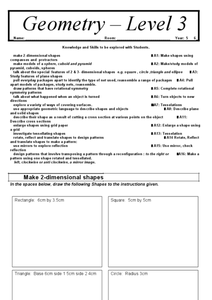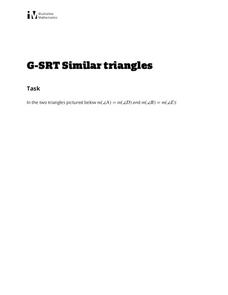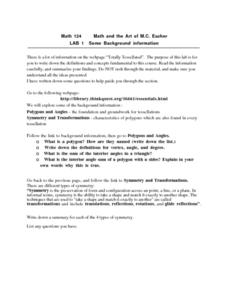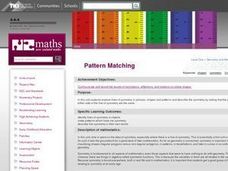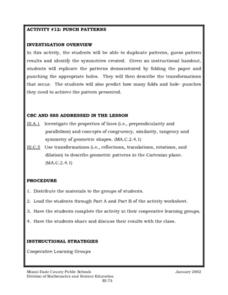EngageNY
Congruence, Proof, and Constructions
This amazingly extensive unit covers a wealth of geometric ground, ranging from constructions to angle properties, triangle theorems, rigid transformations, and fundamentals of formal proofs. Each of the almost-forty lessons is broken...
Curated OER
Geometry Level 3
What a wonderful resource! Learners create two-dimensional shapes according to the instructions stated, use the squares to make a triangular prism, a cube, and a pyramid, and identify features of plane shapes, among a myriad of other...
Curated OER
Geometry Jeopardy!
A list of instructions for this exciting Geometry Jeopardy game is included on slide 2. There are a total of 25 clues and 5 categories, including: solids, triangles, lines, angles, and grab bag. Tip: Play this Jeopardy game with your...
Illustrative Mathematics
Similar Triangles
Proving triangles are similar is often an exercise in applying one of the many theorems young geometers memorize, like the AA similarity criteria. But proving that the criteria themselves are valid from basic principles is a great...
EngageNY
Definition of Congruence and Some Basic Properties
Build a definition of congruence from an understanding of rigid transformations. The lesson plan asks pupils to explain congruence through a series of transformations. Properties of congruence emerge as they make comparisons to these...
Alabama Learning Exchange
The World of Integers
Review operations related to rational numbers and integers using the include PowerPoint presentation, "Interesting Integers." Young mathematicians classify rational numbers as being natural, whole, or integers and read an article about...
Charleston School District
Constructing Dilations
Pupils multiply the vertical and horizontal distances from the center of dilation by the scale factor. The independent practice prompts the class to analyze the relationship between the image and pre-image. The lesson is part three in a...
Charleston School District
Identifying Series and Determining Congruence or Similarity
Learners consider a set of questions to determine a series of transformations that will move one figure to another. Once the series is determined, the pupil then determines whether the pre-image and image are either congruent or similar.
EngageNY
Are All Parabolas Congruent?
Augment a unit on parabolas with an instructive math activity. Pupils graph parabolas by examining the relationship between the focus and directrix.
EngageNY
Are All Parabolas Similar?
Congruence and similarity apply to functions as well as polygons. Learners examine the effects of transformations on the shape of parabolas. They determine the transformation(s) that produce similar and congruent functions.
Curated OER
Math Lab
In this polygons and angles worksheet, 10th graders complete 5 different questions related to polygons and angles, in addition to symmetry and transformations. First, they define polygon and how they are named. Then, students define...
Curated OER
Fold and Cut
Second graders explore line symmetry and the names and attributes of two-dimensional mathematical shapes. They study the context by folding and cutting out shapes to make a series of mathematical shapes.
Curated OER
Pattern Matching
First graders examine how to determine the lines of symmetry in pictures, shapes, and patterns by completing the lessons in this unit. They make patterns that show a line of symmetry and describe it using their own language.
Curated OER
Strawberry and Chocolate Milk
Students listen to the math problem and discuss. They work alone or in groups to come up with the possible solutions and put their pictures of the bottle arrangements on the wall so that the class can refer to them.
Curated OER
Shapes in Motion
Students practice moving different shaped objects through a series of transformations. In groups, they discuss other ways to manipulate the figure to achieve the same results. They solve multiple story problems in the same manner.
Virginia Department of Education
Rotation
Rotate this resource into your lesson plans. Scholars rotate polygons in the coordinate plane by multiples of 90 degrees. They then compare the original and new figures to develop conjectures about coordinate points after rotations.
Curated OER
Transformations
In this transformations instructional activity, pupils draw the transformations of the triangles and parallelograms in graphs. They complete four drawings.
Curated OER
Symmetry with Shapes
Students analyze a symmetrical stamp design with an equal balance of light and dark to create a pattern in succession. In this shape design lesson, students review concepts of sign, symbol and language across cultures. Students analyze...
Curated OER
Punch Patterns
Fifth graders duplicate patterns, guess pattern results and identify the symmetries created. They are given an instructional handout, 5th graders replicate the patterns demonstrated by folding the paper and punching the appropriate...
Virginia Department of Education
Dilation
Open up your pupils' eyes and minds on dilations. Scholars perform dilations on a trapezoid on the coordinate plane. They compare the image to the preimage and develop generalizations about dilations.
Texas Instruments
Transformational Puppet
High Schoolers create a puppet and make predictions using the TI Navigator. In this math lesson, they will discuss their results as they explore transformation. This assignment requires the TI navigator or a smartboard.
Curated OER
A Geometry Worksheet - Similar Triangles
In this similar triangles worksheet, students find the scale factor of 6 sets of similar triangles. Students find the scale factor of two similar triangles given a sketch with measurements. Students use proportions to find a missing side...
Alabama Learning Exchange
I'm Lovin' It: Finding Area Between Curves
Learners explore the concept of finding the area between two curves. In this finding the area between two curves instructional activity, students model the logos of McDonalds, Nike, and Motorola on grid paper. Learners find functions to...
Curated OER
Scenario Challenge
Students create a quilt, using different patterns. In this geometry instructional activity, students apply prior knowledge as they use different patterns to help them create a quilt using transformations and geometric shapes.



